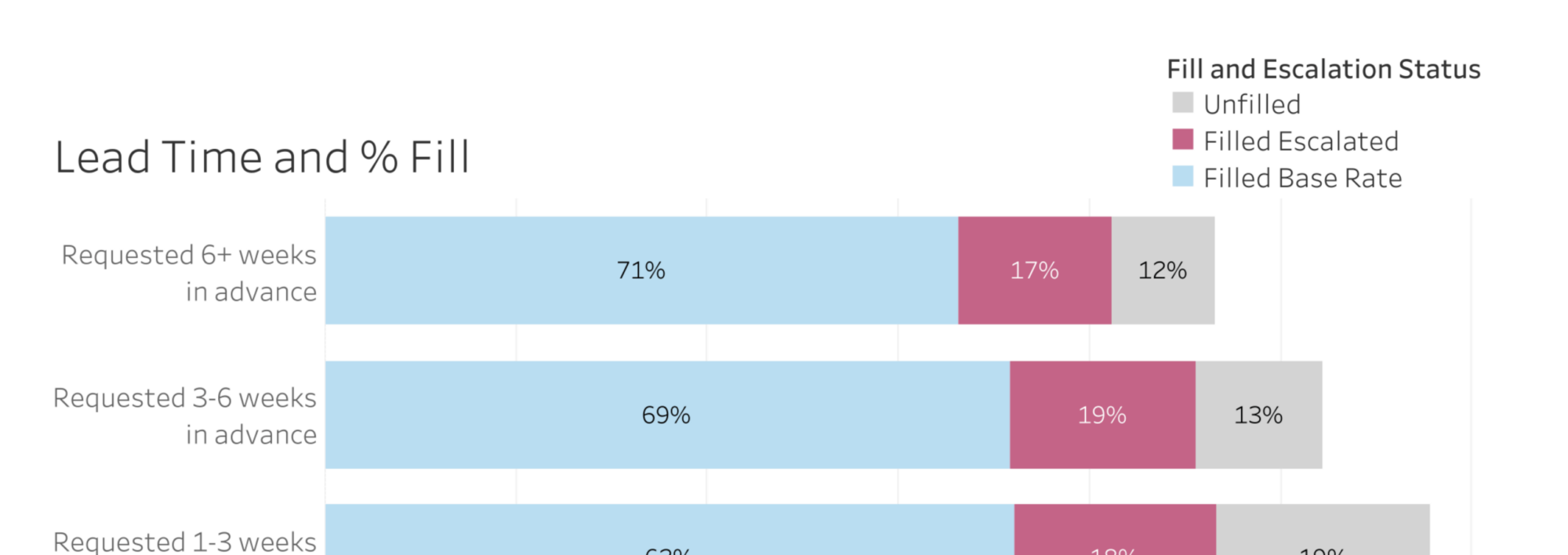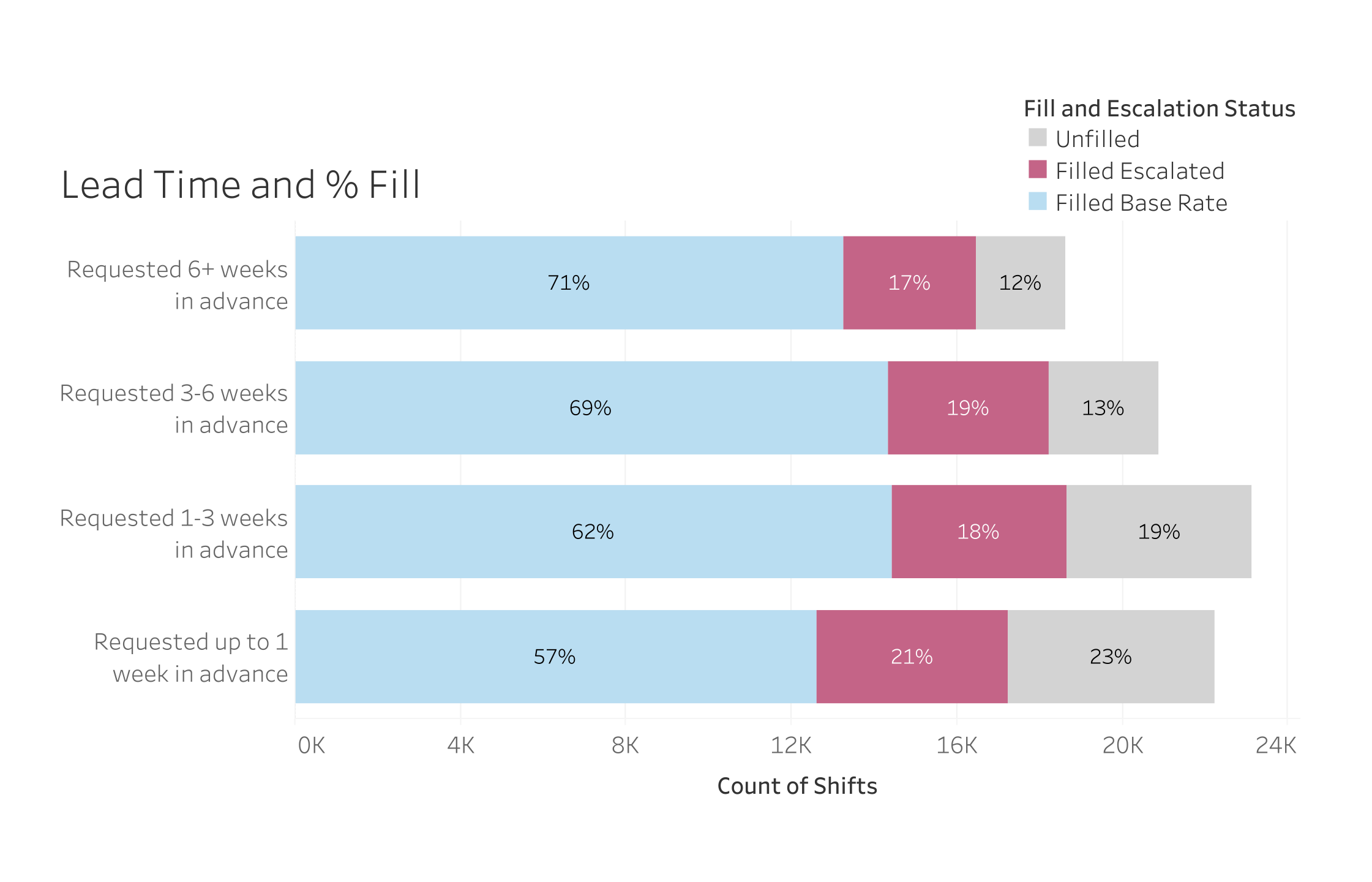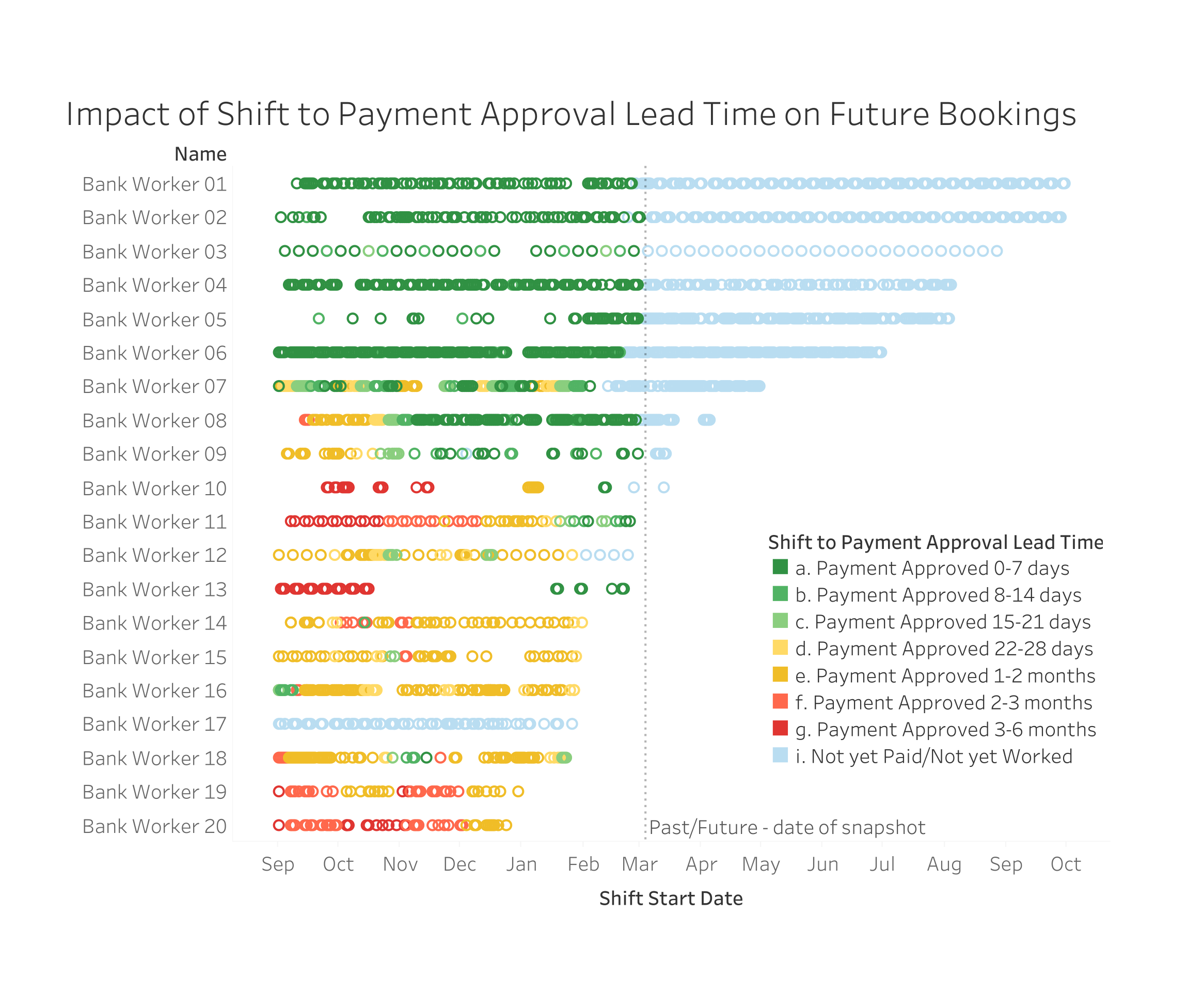5 tactics to improve your NHS bank shift fill rates

Data from NHS England shows a total of 4.7 million people were waiting to start treatment at the end of February 2021 — the highest figure since records began in August 2007. The NHS faces a huge challenge in recovering services and a significant determinant in meeting that challenge will be optimising the use of your NHS bank staff to fill as many shifts as possible.
Using Patchwork’s live data analytics platform, we have collected data from over 100 sites, which use our staffing software for healthcare organisations, to identify 5 best-practice tactics you can introduce to optimise shift fill rates across your organisation.
#1 Request NHS bank shifts as early as possible
Outcomes:
- Shift fill rates were increased by 10%
- The number of shifts at Base Rate (i.e. that did not require escalation) increased by 20%
The NHSE&I target for requesting shifts is at least 6 weeks in advance. Whilst there may be a range of barriers to achieving this, requesting shifts as far in advance as possible is proven to increase your shift fill rate and increase the number of shifts filled at Base Rate. Set aside time to premeditate any upcoming gaps in your rota, such as upcoming parental leave, long-term staff absence and planned training courses, to enable you to request shifts as early as possible.
Our data shows that:
- On average, shifts requested at least 6-weeks in advance have a 10% higher fill rate than shifts that are requested up to 1-week in advance.
- 71% of shifts requested at least 6-weeks in advance were filled at Base Rate, which was 14% higher than the shifts requested up to 1 week in advance (only 57% of these shifts were filled at Base Rate).
- In one Trust where we have seen consistently high fill rates, 91% of shifts requested at least 6 weeks in advance were filled at Base Rate. This was 21% higher than shifts that were requested up to 1 week in advance, where only 70% were filled at Base Rate.
Figure 1: Snapshot of Unfilled: Filled Escalated:Filled Base Rate shifts across our partner organisations

#2 Look at the effectiveness of your existing NHS bank staff
Outcome: Improved engagement from trust’s existing NHS bank staff
Across our partner trusts’ digital staff banks, we have identified the following worker trends:
- Career locums who tend to book 15+ shifts per month
- Bank workers who pick up a few shifts per month on an ad-hoc basis
- Bank workers who book shifts for several consecutive months and then reduce booking activity
- Bank workers who have been onboarded, but are yet to book a shift
It is important to begin by investigating engagement patterns and exploring why workers behave in certain ways. Has something changed which is causing them to stop booking shifts? Do any of their credentials need updating? Are they still available to work?
Watch on-demand > How user behaviours can impact the success of your staff bank
Many NHS bank workers can feel secondary to substantive staff. To avoid this, we recommend regularly engaging with workers on your bank to create a sense of belonging and thus encourage an uptake in shift booking. It is also beneficial to identify any bank workers who are no longer available to work; this will provide insight into how large your active pool of workers really is.
By utilising and engaging with the bank you currently have, you will optimise the effectiveness of your existing pool of NHS bank staff and form a better understanding of how many additional bank workers you should aim to recruit.
#3 Onboard newly recruited bank workers promptly
Outcome: Quickly onboarded NHS bank staff had a higher engagement and retention rate
Encouraging more staff to join your bank is of course always beneficial, helping to spread the load across a wider pool of staff to minimise NHS staff burnout and improve your fill rates. However, to ensure the success of your recruitment programme, onboarding is key. The data is clear: NHS bank staff who have been onboarded quickly tend to book more shifts. We have found that workers who experienced a longer gap between registration and approval not only take longer to book their first shift, but are more likely to remain inactive and never book a first shift.
Review your list of clinicians who need to complete the onboarding process and see what steps need to be taken. We recommend setting a target to approve registered workers in less than 7 days wherever possible. This positive experience from the offset will encourage workers to become active members of your NHS staff bank.
Figure 2: Each circle in the graph below represents an individual

#4 Ensure prompt sign-off, approval and payment for NHS bank shifts
Outcomes:
- The number of shifts worked by NHS bank staff increased
- Bank workers booked more shifts in advance
As highlighted in Figure 3 below, the highest number of shifts are undertaken by staff who regularly have their shifts approved for payment within 7 days of the shift being worked. Where payment has taken several months to approve, the number of shifts worked by an individual falls significantly. To support our partner organisations to bring flexible pay to healthcare and improve the financial wellbeing of their workers, Patchwork has partnered with leading financial wellness company Wagestream. Wagestream is funded by social impact charities in order to help bring financial security and stability to the lives of working people by challenging the negative effects of the monthly pay cycle.
Figure 3: Each circle in the graph below represents an individual

On a more granular level, we discovered prompt payment also resulted in NHS bank workers pre-booking a higher number of shifts further in advance (Figure 4). Comparatively, individuals who experienced long wait times between working a shift and approval for payment were unlikely to book shifts for future dates (Figure 4). Review your shift:payment lead times to check whether any members of staff are waiting long periods of time to be paid. By improving your payment process, you will increase the number of shifts booked by clinicians in the future and grow their confidence in working with your organisation.
In Figure 4, we can see how NHS bank staff whose shifts are approved for payment within 1-3 weeks (the green circles) are more likely to book shifts regularly and well into the future, confident that they will be paid promptly after they’ve worked their shift. NHS bank staff who’ve experienced a long wait for payment approval (the yellow/orange/red circles) are less likely to book shifts for dates in future. They may be hesitant to book any further shifts until they’ve been paid, or may stop booking shifts altogether.
Figure 4: Each circle represents a shift and the colours are how long it took for that shift to be approved for payment. The vertical dotted line represents when the snapshot was taken, delineating between past and future dates.

#5 Escalate pay rates appropriately for hard-to-fill shifts
Outcome: Ensure hard-to-fill shifts are covered in advance
While escalated pay rates come with an increased cost, some shifts need escalating to ensure they are filled and this should be done early and appropriately with the right financial controls in place. During a 6-month period across all of Patchwork’s partner organisations, 89% of escalated shifts were filled. By selecting a fully interoperable staffing software for healthcare organisations, shifts can be automatically escalated between your rostering solution, your NHS bank and your vendor management system (VMS), ensuring no time is wasted on admin and all shifts are filled. Our rate escalation tool automatically ensures that only appropriate shifts are escalated with the right level of approval.
In conclusion
These five key tactics drawn from country-wide hospital staffing data have a common theme: a forward-oriented, proactive approach is essential to the delivery of successful staffing outcomes.
Patchwork Health is working hard to support our partners in building strong internal and collaborative NHS banks, enabling successful advance shift advertisement and capacity building. For further information on how you can increase the shift fill rate at your NHS bank, please email hello@patchwork.health and one of the Patchwork team will be happy to advise.
Find out how to establish a safe, sustainable and modern staffing solution with Patchwork Health